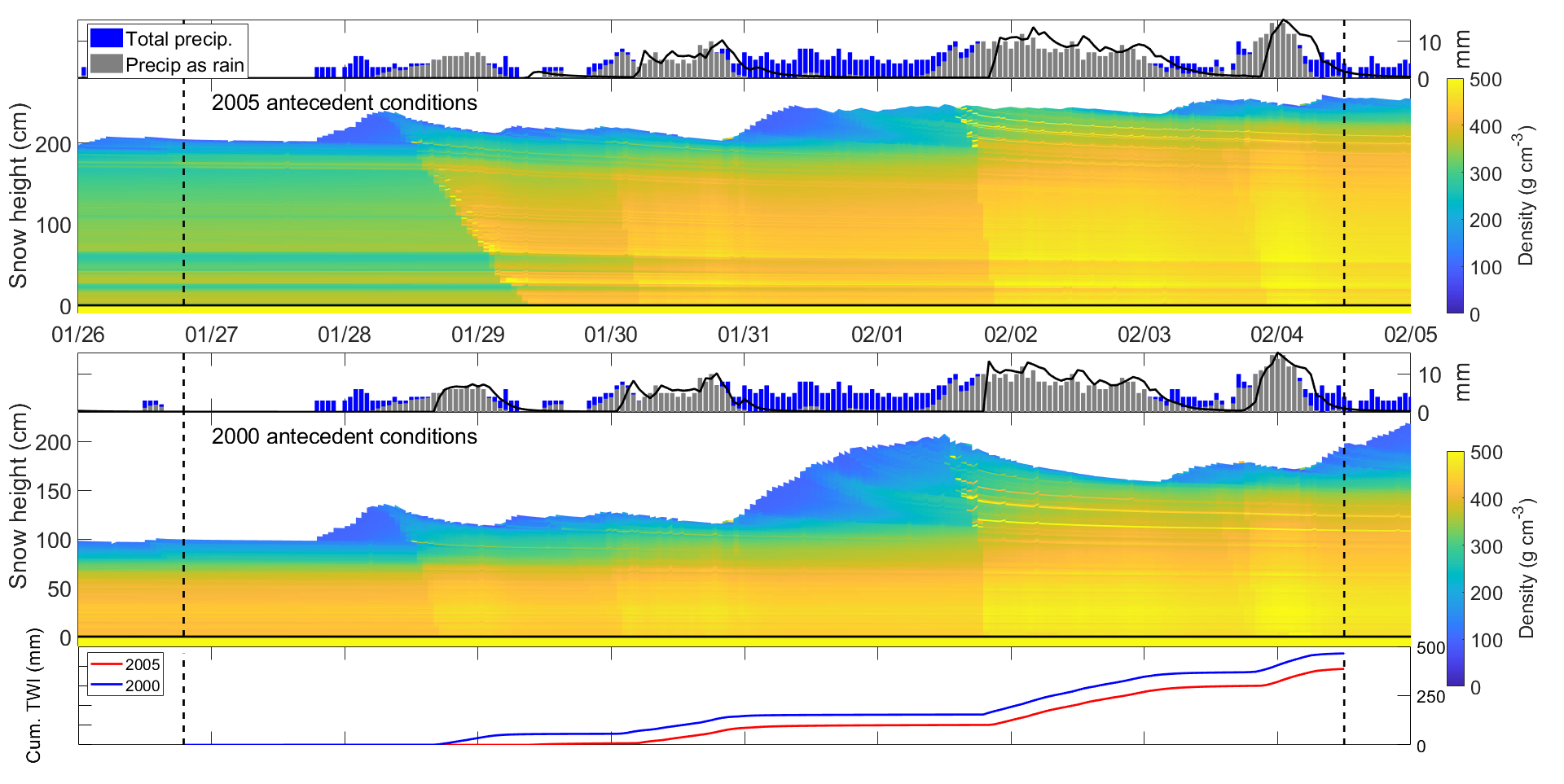CW3E Publication Notice
Antecedent Snowpack Cold Content Alters the Hydrologic Response to Extreme Rain-on-Snow Events
December 4, 2023
A new paper titled “Antecedent Snowpack Cold Content Alters the Hydrologic Response to Extreme Rain-on-Snow Events” by Lisa Katz (University of Nevada, and now CW3E), Gabriel Lewis (University of Nevada, and now CW3E), Sebastian Krogh (University of Concepción), Stephen Drake (University of Nevada), Erin Hanan (University of Nevada), Benjamin Hatchett (University of Nevada/Desert Research Institute), and Adrian Harpold (University of Nevada) was recently published in the Journal of Hydrometeorology. This paper examines rain-on-snow (ROS) events in California’s Sierra Nevada, focusing on the controls that antecedent snowpack conditions, namely snowpack cold content, snow density, snow water equivalent (SWE), and liquid water content, have on the timing and magnitude of liquid drainage from the snowpack onto the land surface. By furthering our understanding of how hydrometeorological models interpret meteorological and watershed interactions during complex events such as ROS, this work advances CW3E’s 2019–2024 Strategic Plan goal to improve modeling capabilities to better serve water supply management programs in the western U.S., such as Forecast Informed Reservoir Operations (FIRO) and flood warning systems.
The researchers modeled 71 ‘historical’ ROS events between 1981 and 2019 true to the record, and created ‘scenario’ events for modeling, by exposing a set of 40 unique snowpack states to meteorological conditions from the most extreme ROS. The model used was the physically based, 1-dimensional SNOWPACK, initiated with the Richards Equation. Results from this study agreed with previous studies that rainfall is the dominant control on TWI during ROS (R2 = 0.95, p < 0.01), and found that terrestrial water input (TWI) is largely generated at higher elevations, where rainfall amount is greatest. This study adds that snowpacks with more negative cold content reduce the ratio of TWI to rain over the event duration. Scenario event TWI to rain ratio responses spanned the range from ≤ 1 to > 1, providing evidence for snowpacks storing rain or meltwater, depending on antecedent snowpack conditions.
An analysis of antecedent snowpack conditions by multiple linear regression (R2 = 0.92, p < 0.01) determined that cold content, over snow density, liquid water content, or SWE, produced the highest Pearson correlation with TWI (0.75, p < 0.01), and even stronger relationships were found for cold content–liquid water content (0.89, p < 0.01) and cold content–density (0.81, p < 0.01). These results suggest that refreezing from higher cold content and slower unsaturated flow from higher snow density lead to more liquid water retention during ROS events.
Antecedent cold content is a rarely measured snowpack state that is the result of several interconnected snowpack processes and could lead to useful observations for streamflow forecasting. A combination of refreezing, matric forces, or reductions in hydraulic conductivity from dense vertical layering may cause the larger retention of rainfall and/or TWI than would be predicted by a simple refreezing of the snowpack in a single snow layer. This retention may be partially due to rainfall and cold content being larger at the higher elevations, affecting the catchment average. Results from this study highlight the importance of hydraulic limitations in dense snowpacks and energy limitations in warm snowpacks for retaining liquid water that would otherwise be available as TWI for flooding.
Figure 1: (Figure 6 from Katz et al. 2023) Scenario analysis of 1986 ROS event at High falling (top) on the cold and dry antecedent snowpack conditions from 26 Jan 2005 and (middle) the warm and wet antecedent snowpack conditions from 26 Jan 2000. The upper panels show hourly rain and precipitation (bars) as well as resulting TWI (black). (bottom) Cumulative TWI from 2000 (blue) and 2005 (red) antecedent conditions. Dashed vertical lines indicate the ROS event start and end.
Katz, L., Lewis, G., Krogh, S., Drake, S., Hanan, E., Hatchett, B., & Harpold, A. (2023). Antecedent Snowpack Cold Content Alters the Hydrologic Response to Extreme Rain-on-Snow Events. Journal of Hydrometeorology, 24(10), 1825-1846. https://doi.org/10.1175/JHM-D-22-0090.1

